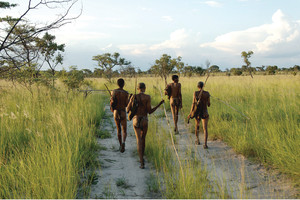
Stephan C. Schuster / Penn State UniversityMembers of the tribe of hunters and gathers in Namibia: customs preserved for hundreds of generationsStephan C. Schuster / Penn State University
For tens of thousands of years, the Khoisan of southern Africa was the largest population on the planet. Only 22,000 years ago, these cattle grazing, hunting-and-gathering people began to lose ground to other ethnic groups in Africa, including those from which the European and Asian races arose. Today, there are 100,000 Khoisan speakers, compared to all other ethnic groups combined, which total seven billion people. Ever since they split from the other lineage of modern humans between 150,000 and 100,000 years ago, the Khoisan people have been isolated, according to a study by Stephan Schuster at Pennsylvania State University. Schuster and his collaborators, including Brazilian Álvaro Montenegro Neto at São Paulo State University in São Vicente and Ohio State University, sequenced the genomes of five Khoisan and one Bantu speakers. They then compared them with eight other genomes and 420,000 genetic variations in 1,462 people from 48 ethnic groups. They discovered that the Khoisan are distinct not just from Europeans and Asians but also from other Africans (Nature Communications, December 4, 2014). The genetic diversity maintained by the Khoisan since their separation from other humans suggests that in the past, their population was larger than that of other groups.
Republish
